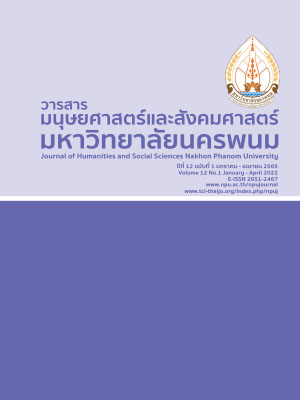Developing Scientific Literacy through Context-based Learning with Technology involving Acid-Base Topics for 11th Grade Students
Main Article Content
Abstract
This classroom action research aimed to study the possibilities of learning management using context-based learning in conjunction with technology. The study was designed to improve the scientific literacy of 11th grade students when studying in acid-base topics. The control sample consisted of twenty-two 11th grade students. The research tools were comprised of the three lesson plans, a reflective learning management form, students’ worksheets, and a scientific literacy test. Data assessment was performed by content analysis. The testing scores provided the achievement level of scientific literacy and were based on the Programed for International Student Assessments (PISA) 2015 science framework. The triangulation method was employed to ensure credibility of this research. The results of this research indicated that context-based learning in conjunction with technology management was essential for the development of scientific literacy. The development process consisting of four phases, which included the context of presentation: teacher(s) presented the quality of students’ surroundings by using videos or infographics with explanatory details. Afterwards, the teacher asked questions designed to motivate students to try and identify the scientific problems; and then, selecting problem which is to be solved in the classroom. In second phase, Taking Action: students designed an inspection method and carried out the experiment using available technology driven methods, such as an application on a smartphone, a chemistry lab simulator program, or social media. Several technological methods were used by students while searching for information, gaining knowledge, communicating with classmates, or verifying inspection method throughout the survey. Third phase, Learning Key Concept: teacher(s) encouraged students to analyze the data, design a presentation using a graphic design website, and later discuss the results. Finally, the fourth phase, Recontextualize: teacher(s) presented students with an analogous context extracting from a social media source. The result from the scientific literacy post-test indicated an increasing of scientific literacy score of 2. Such literacy score showed the ability to participate actively in life situations related to science and technology as comparing to the pre-test score of 1b, reading competency at the lowest level.
Article Details

This work is licensed under a Creative Commons Attribution-NonCommercial-NoDerivatives 4.0 International License.
References
Chanapimuk K. (2020). [Promoting Scientific Literacy by using Science, Technology, Society, and Environment (STSE) approach of Grade 11th Students on the Topic of Plant Growth]. Journal of Education Naresuan University, 22(2), 62-73.
Chindanurak T. (2017). khrū læ nakrīan nai yuk kānsưksā Thai 4.0 [Teachers and Students in Thailand Education 4.0]. Electronic Journal of Open and Distance Innovative Learning (e-JODIL)., 7(2), 14-29.
Damjub W. (2019). sư̄ sangkhom ʻō̜nlai kap kānrīanrū nai satawat thī yīsipʻet [Social Media for Teaching and Learning in the 21st Century]. Journal of Liberal Arts, Maejo University, 7(2), 143-159.
Davenport J., Rafferty A., and Yaron D. (2018). Whether and How Authentic Contexts Using a Virtual Chemistry Lab Support Learning. Journal of Chemical Education. 95(8), 1250-1259.
IPST. (2018). phonkān pramœ̄n PISA sō̜ngphansiphā witthayāsāt kān ʻān læ khanittasāt. [The result PISA 2018 Reading Mathematical and Science]. Bangkok: IPST.
IPST. (2021). phonkān pramœ̄n PISA sō̜ngphansippǣt kān ʻān khanittasāt læ witthayāsāt [The result PISA 2018 Reading Mathermatical and Science]. Bangkok: IPST.
National Science Technology and Innovation Policy Office. (2009). nayōbāi læ phǣn witthayāsāt theknōlōyī læ nawattakam hǣng chāt chabap thī nưng [National Science Technology and Innovation Policy No.1]. Bangkok; Ministry of Science and Technology.
Nimla-or P. (2017). phonkān chai nǣokhit kānrīanrū dōi chai bō̜ribot pen thān thī mī tō̜ khwāmkhaočhai manō that chīwawitthayā khō̜ng nakrīan matthayommasưksā tō̜n plāi [Effects of Using Contex-Based Learning Approach on Conceptual Understanding in Biology of Upper Secondary School Students]. An Online Journal of Education, 12(2), 224-238.
Oebsuksiri A. (2014). čhittawitthayā samrap khrū [Psychology for Teacher]. 2nd ed. Bangkok; Chulalongkorn University Press.
Overtoon, T. L., Byers B., and Seery, M. K. (2015). Context and Problem based Learning in Higher Level Chemistry Education: Innovation Methods of Teaching and Learning Chemistry in Higher Education. UK: RSC Publishing.
Pattiyatanee, S. (2017). kān watphon kānsưksā [Educational measurement]. 11th ed. Kalasin: Prasarnkarnpim.
Phabchai P. (2020). kānphatthanā kān rū witthayāsāt dōi chai kānčhatkān rīanrū thī chai bō̜ribot pen thān rư̄ang krot - bēt samrap nakrīan chan matthayommasưksā pī thī hā [Developing Scientific Literacy in the Topic of Acid-Base Using Context-Based Learning Management for Grade 11th Students]. Journal of Education Naresuan University, 22(3), 164-176.
Prins G., Bulte A., and Pilot A. (2018). Designing context-based teaching materials by transforming authentic scientific modelling practices in chemistry. International Journal of Science Education, 40(10), 1108-1135.
Reangrit N. (2017). ʻin fōkrāfik kap kānʻō̜kbǣp sư̄ kānsō̜n [Infographic and Instructional Design], Journal of Education, Silpakorn University, 15(2), 29-40
Sakulwichitsintu S. (2017). kānchai theknōlōyī sārasonthēt phư̄a kānrīanrū rūam kan thāng ʻō̜nlai [UsingInformation Technology for Online Collaborative Learning]. Veridian E-Journal, Silpakorn University (Humanities, Social Sciences and arts), 10(2), 437-450.
Srinarang W. (2019). theknōlōyī phư̄a kānrīanrū nai satawat thī yīsipʻet [Technology for Learning in the 21st Century]. IPST Magazine, 47(219), 26-29.
Watayotha K. (2019). khwāmkhit sāngsan khō̜ng phū rīan thī rīan dūai singwǣtlō̜m thāngkān rīanrū mantimīdīa rūam kap theknōlōyī samư̄an čhing tām nǣo khō̜n satraktiwit thī songsœ̄m khwāmkhit sāngsan rư̄ang kānsāng san chin ngān dūai krabūankān theknōlōyī samrap nakrīan chan matthayommasưksā pī thī sō̜ng [Creative Thinking of the Learners with Constructivist Multimedia Learning Environment and Augmented Reality to Promote Creative Thinking on the topic of Product Creation by Technological Process for Grade 8 Students]. Veridian E-Journal, Silpakorn University (Humanities, Social Sciences and arts), 12(2), 499-518.


